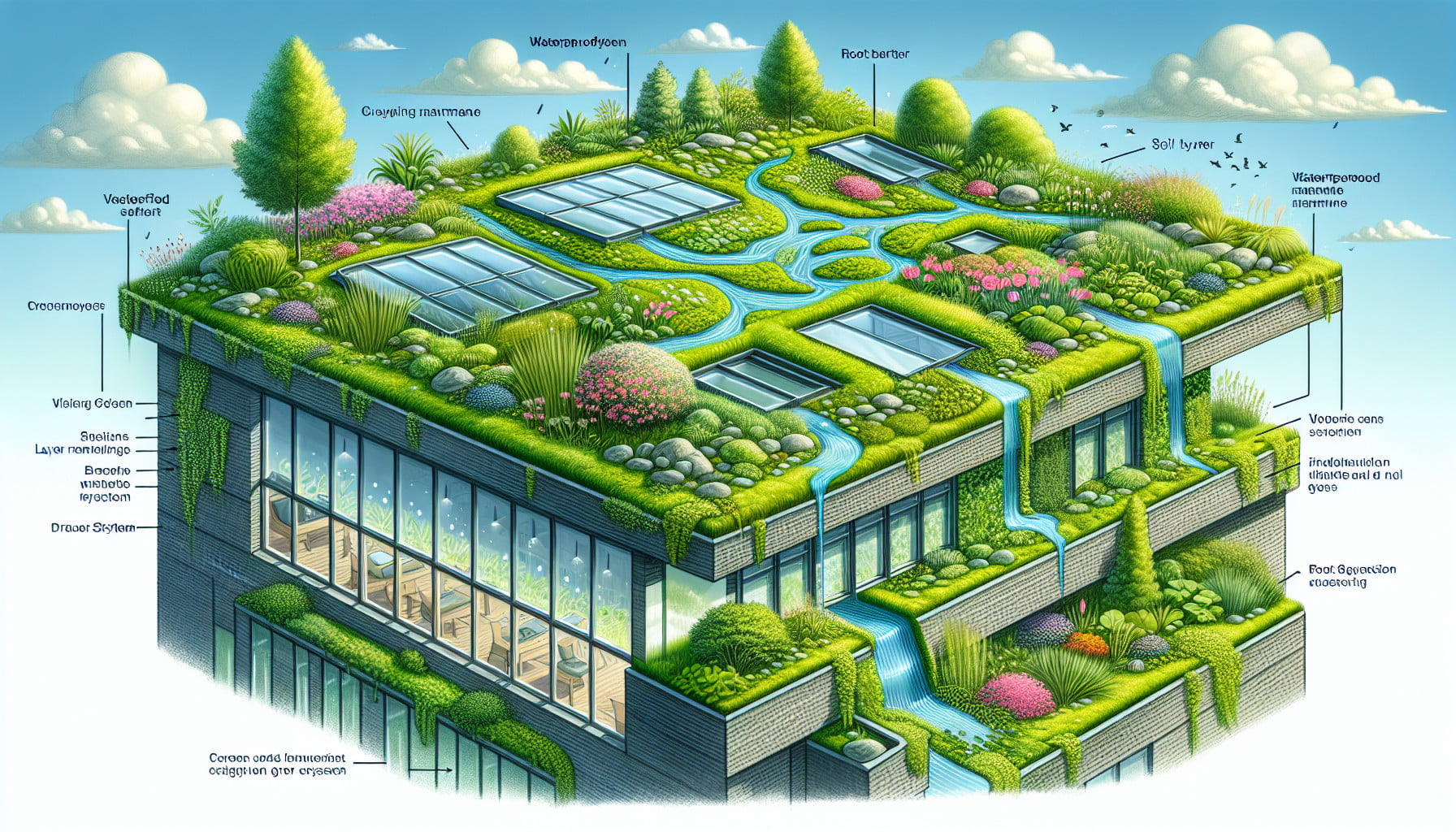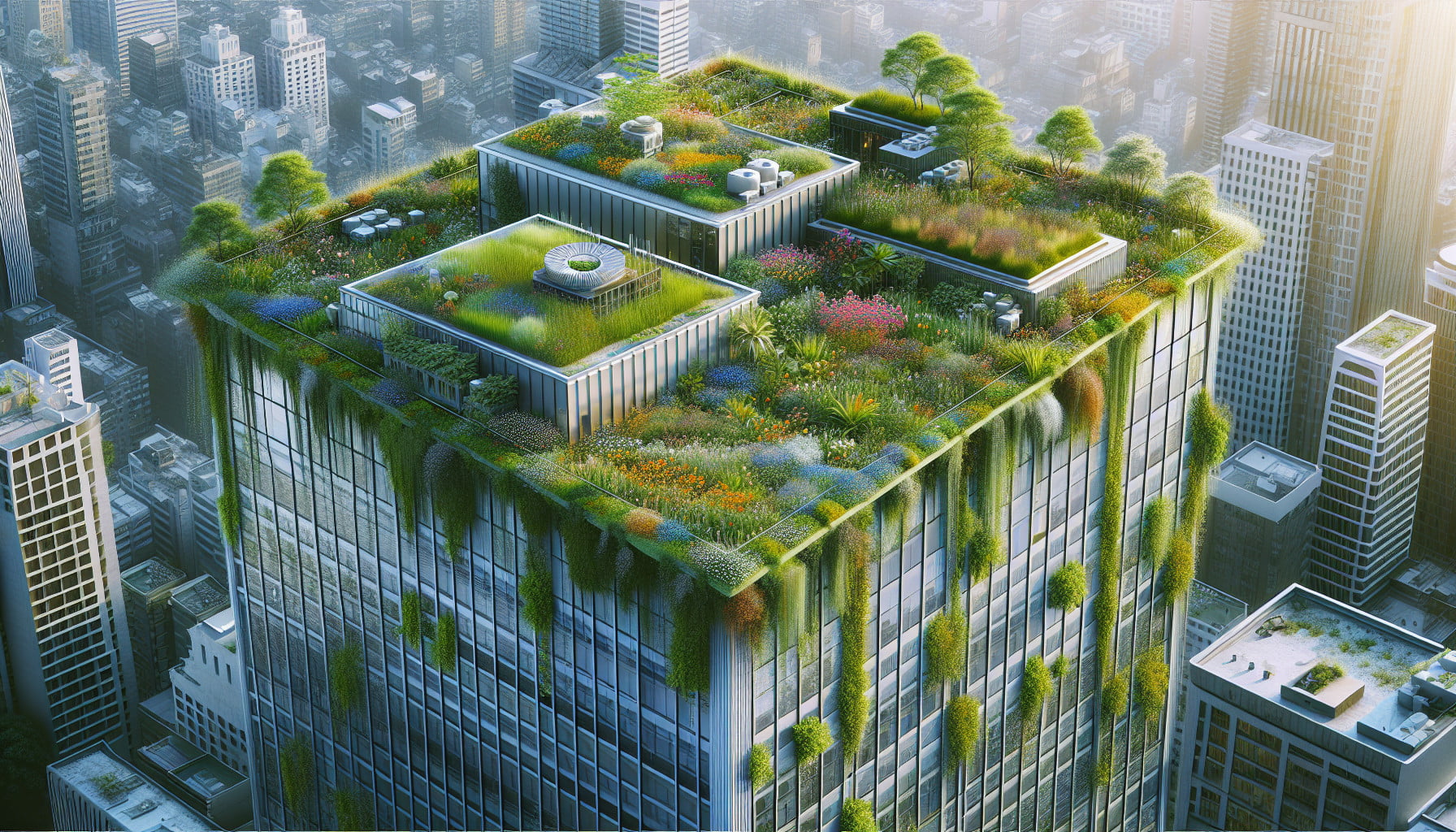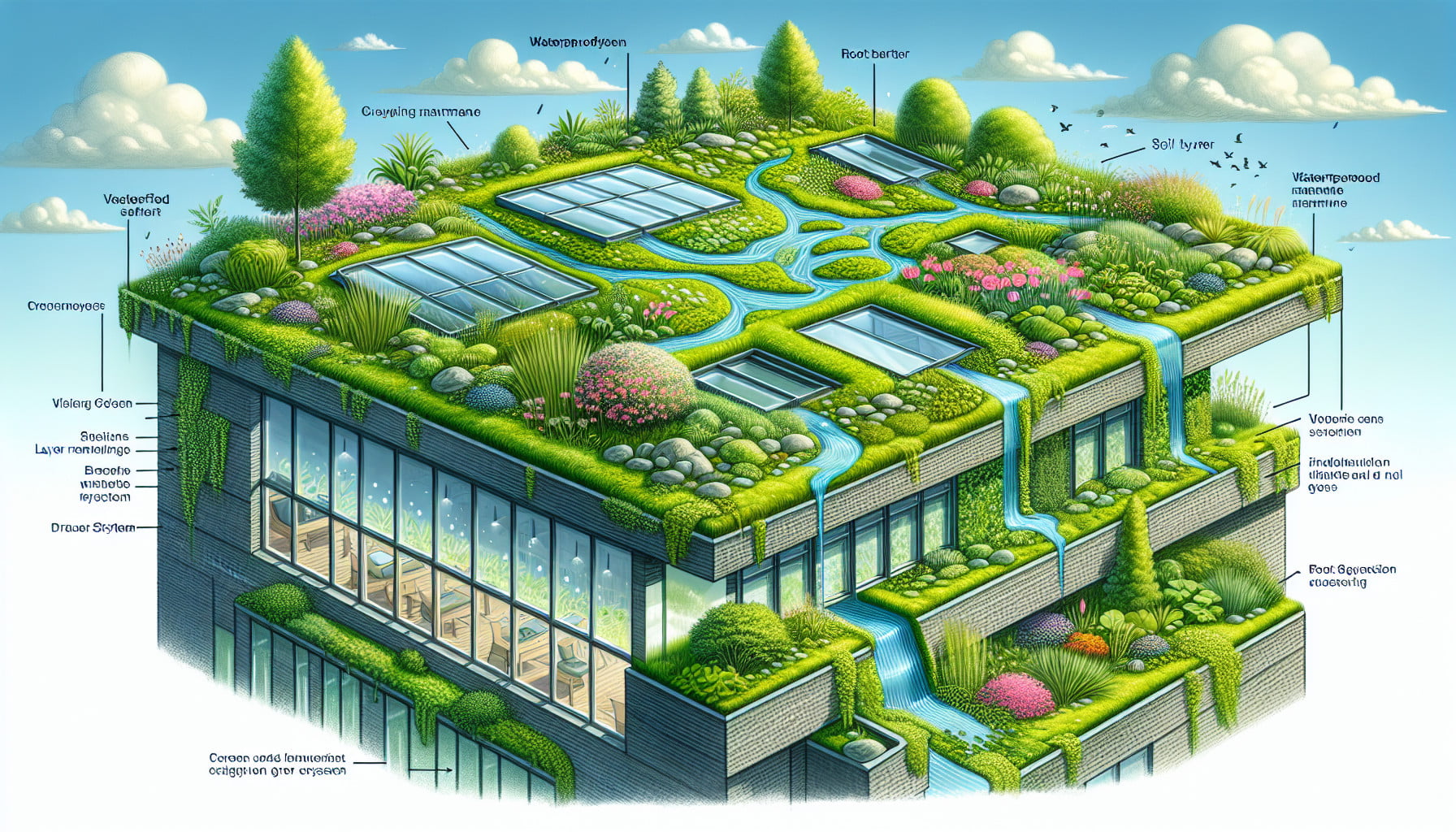Imagine transforming the top of your building into a thriving oasis of greenery, offering numerous benefits for both the environment and your own well-being. A successful green roof is a testament to sustainability and innovation, providing insulation, reducing stormwater runoff, and improving air quality. In this article, you will discover the seven essential components that make up a prosperous green roof, helping you create your own urban paradise. Get ready to be inspired by the possibilities that lie ahead!
Structural Integrity
Load-Bearing Capacity
When designing a green roof, one of the most important considerations is its load-bearing capacity. The roof must be able to support the weight of the vegetation, growing medium, and any additional structures or equipment. It is crucial to consult with a structural engineer to ensure that your roof can handle the added load. Reinforcements may be necessary to strengthen the existing structure and prevent any potential collapse or damage.
Supporting Material
To maintain the structural integrity of a green roof, it is essential to choose suitable supporting materials. The selection of materials will depend on the specific requirements of the roof, such as weight distribution, insulation properties, and durability. Materials commonly used include high-quality membranes, insulation boards, and root barriers. These materials help to provide a stable and secure foundation for the rest of the green roof components.
Waterproofing
Proper waterproofing is a critical element of a successful green roof. It prevents water leakage and protects the underlying structure from damage caused by moisture. A waterproofing membrane is typically installed beneath the green roof system to ensure effective water resistance. This membrane acts as a barrier, preventing water from seeping into the roof structure and causing potential problems such as leaks, mold, or rotting.
Drainage System
Drainage Layer
A well-designed drainage system is vital to ensure proper water management on a green roof. The drainage layer allows excess water to flow out of the system, preventing waterlogging and potential damage to the roof structure. The layer consists of a series of perforated pipes or channels that collect and redirect water away from the roof. It is crucial to choose a drainage layer that can handle the anticipated water flow and effectively distribute it across the entire roof surface.
Drainage Outlets
Drainage outlets play a crucial role in maintaining the health of a green roof by preventing water accumulation. These outlets provide an exit point for excess water to drain out of the system. They are strategically placed to ensure optimal drainage and prevent any potential issues, such as standing water or overloading of the system. Regular inspection and maintenance of the drainage outlets are necessary to ensure their proper functioning and prevent any blockages.
Slope
The slope of a green roof is another important aspect that directly impacts its drainage capabilities. The roof should be properly graded to allow water to flow towards the drainage outlets. The recommended slope for a green roof is typically between 2-5% to ensure efficient water runoff. A well-designed slope will prevent stagnant water pools, which can lead to plant damage, root rot, and structural issues. Proper grading and slope design are crucial for a successful green roof.

Growing Medium
Depth
The depth of the growing medium is a critical factor in the success of a green roof. Sufficient depth allows plants to establish robust root systems and access the necessary nutrients and moisture. The recommended depth for extensive green roofs is typically between 2-6 inches, while intensive green roofs may require deeper growing mediums, ranging from 6-12 inches or more. The depth of the growing medium should be carefully considered based on the intended vegetation and the overall load-bearing capacity of the roof.
Composition
The composition of the growing medium is essential for providing adequate support and nutrition to the plants. A well-balanced mix of organic and inorganic materials is typically used to promote healthy plant growth. Organic materials, such as compost, help retain moisture and provide nutrients, while inorganic materials like lightweight aggregates enhance drainage and prevent compaction. The composition of the growing medium should be carefully chosen to meet the specific needs of the selected plant species and optimize their growth potential.
Nutrient Content
The nutrient content of the growing medium is crucial for the long-term health and vitality of the green roof vegetation. The growing medium should contain a balanced blend of essential nutrients to support plant growth and development. This can be achieved through the addition of organic fertilizers or the incorporation of nutrient-rich materials into the growing medium. Regular monitoring of nutrient levels and periodic fertilization are necessary to ensure optimum plant health and promote a thriving green roof ecosystem.
Vegetation Selection
Plant Types
Choosing the right plant types for a green roof is essential for creating an aesthetically pleasing and sustainable ecosystem. Selecting plants that are well-suited to the local climate, have low water requirements, and can withstand the rooftop conditions is crucial. Sedums, grasses, and herbaceous perennials are often popular choices for extensive green roofs due to their ability to thrive in shallow soil depths. Intensive green roofs can accommodate a wider range of plant types, including trees, shrubs, and even vegetable gardens.
Compatibility
When selecting vegetation for a green roof, it is essential to consider the compatibility of different plant species. Certain plants may have different growth rates, light requirements, or water needs, which can affect their ability to coexist harmoniously. It is important to choose plant species that can thrive together and complement each other’s growth habits. Compatibility considerations can help prevent competition for resources and ensure a well-balanced and sustainable green roof ecosystem.
Maintenance Requirements
Different plant species have varying maintenance requirements, and this should be taken into account when selecting vegetation for a green roof. Some plants may require regular pruning, fertilization, or pest control, while others are more self-sufficient and low-maintenance. It is important to choose plant species that align with the available resources and maintenance capabilities. Prioritizing low-maintenance plants can help reduce the overall maintenance burden and ensure the longevity of the green roof.

Irrigation and Water Management
Irrigation System
Proper irrigation is crucial for maintaining the health and vitality of a green roof. An efficient irrigation system should be designed to deliver the required amount of water to the vegetation without excessive runoff or water wastage. Drip irrigation, microsprinklers, or subsurface irrigation systems are commonly used in green roofs to ensure precise water delivery directly to the plant roots. The irrigation system should be carefully calibrated and regularly monitored to ensure optimal water distribution and plant health.
Water Retention
Water retention is an important aspect of green roof design, especially in areas with limited rainfall or during dry periods. A green roof should have the ability to retain moisture within the growing medium to sustain the vegetation during periods of water scarcity. This can be achieved through the inclusion of moisture retention additives in the growing medium or the use of specialized irrigation systems that promote water conservation. Maximizing water retention helps reduce the reliance on external water sources and promotes the overall sustainability of the green roof.
Watering Schedule
Establishing an appropriate watering schedule is crucial for maintaining the health and well-being of the vegetation on a green roof. The watering schedule should be based on the specific needs of the selected plant species, local climate conditions, and time of year. The frequency and duration of watering should be carefully adjusted to avoid both underwatering and overwatering, which can lead to plant stress, disease, or root rot. Regular monitoring of soil moisture levels and plant health indicators can help fine-tune the watering schedule for optimal results.
Insulation
Thermal Insulation
Green roofs provide an additional layer of insulation, which can help regulate the temperature of the building below. The vegetation, growing medium, and air trapped within the green roof system act as effective thermal insulators, reducing heat loss in the winter and heat gain in the summer. The insulating properties of a green roof can contribute to energy savings, improve indoor comfort, and reduce the heating and cooling demands of the building.
Sound Insulation
In addition to thermal insulation, green roofs also offer sound insulation benefits. The vegetation and growing medium absorb and deflect sound waves, reducing noise pollution from the surrounding environment. This can be particularly beneficial in urban areas with high levels of noise, improving the quality of life for building occupants. Green roofs can create a quieter and more peaceful environment, promoting mental well-being and overall comfort.
Energy Efficiency
The insulation properties of green roofs contribute to improved energy efficiency within the building. By reducing heat transfer through the roof, green roofs can lower the demand for heating and cooling, resulting in energy savings. This can help reduce the carbon footprint of the building and contribute to a more sustainable and environmentally friendly approach to energy consumption. Green roofs are a valuable addition to building design, promoting energy efficiency and mitigating the urban heat island effect.
Access and Safety
Roof Access Points
Providing safe and convenient access to the green roof is essential for maintenance and recreational purposes. Roof access points should be strategically located to ensure easy entry and exit without causing damage to the vegetation or the roof structure. Designated access points, such as stairs or ladders, should comply with safety regulations and be equipped with handrails or other safety features. Ensuring adequate access to the green roof promotes regular maintenance and enhances enjoyment of the space.
Walkways
Walkways play a crucial role in green roof design by facilitating movement and minimizing damage to the vegetation. They provide designated paths for maintenance personnel and visitors, helping to distribute weight evenly and prevent soil compaction. Walkways should be designed with non-slip surfaces, be wide enough to accommodate foot traffic, and be constructed from materials that are resistant to damage from foot traffic and weather conditions. Properly designed walkways ensure safe access to the green roof while minimizing the risk of damage to the ecosystem.
Safety Measures
Safety measures should be implemented to minimize the risk of accidents or injuries on a green roof. These measures can include the use of guardrails or protective barriers around the roof perimeter to prevent falls, as well as signage indicating potential hazards and safety precautions. Regular inspection and maintenance of safety features are necessary to ensure their effectiveness and prevent any safety breaches. Prioritizing safety on a green roof is crucial to protect both the occupants and the surrounding environment.
Ecological Considerations
Native Plant Species
Incorporating native plant species into a green roof is crucial for enhancing ecological sustainability and promoting biodiversity. Native plants have adapted to local climate conditions, making them more resilient and better suited to thrive on a green roof. They also provide habitat and food sources for local wildlife, supporting the overall ecosystem. By using native plant species, green roofs can contribute to the conservation of local flora and fauna and help restore natural habitats within urban environments.
Biodiversity
Encouraging biodiversity on a green roof goes beyond selecting native plant species. Incorporating a variety of vegetation types, such as grasses, flowering plants, and shrubs, creates different microhabitats that can support a diverse range of insects, birds, and other wildlife. Providing food sources, shelter, and nesting opportunities for various species helps promote ecological balance and resilience. Green roofs can serve as ecological corridors, allowing wildlife to move through urban areas and increasing overall biodiversity.
Pollinator Habitats
Green roofs can play a vital role in supporting pollinators, such as bees and butterflies, by providing them with a source of food and habitat. Including flowering plants that attract pollinators, such as native wildflowers, can help create valuable pollinator habitats on the roof. These habitats contribute to the overall pollination of plants, enhance biodiversity, and support the health of local ecosystems. Green roofs can serve as vital stepping stones in the conservation of pollinator populations, helping to maintain essential ecological services.
Maintenance and Upkeep
Regular Inspection
Regular inspections are essential to identify and address any maintenance issues or potential problems on a green roof. Inspections should be conducted at least twice a year, but more frequent inspections may be necessary in areas with harsh weather conditions or high foot traffic. During inspections, the integrity of the roof structure, the condition of the vegetation, and the performance of the drainage and irrigation systems should be evaluated. Timely identification of issues and prompt maintenance can prevent small problems from escalating into larger and more costly repairs.
Weeding and Pruning
Weeding and pruning are necessary maintenance tasks to ensure the health and aesthetic appeal of a green roof. Weeding helps remove unwanted plants or invasive species that can disrupt the balance of the ecosystem. Regular pruning of vegetation promotes healthy growth, maintains desired shapes, and prevents overcrowding. It is important to use proper pruning techniques and tools to avoid damaging the plants or the roof structure. Weeding and pruning should be performed regularly, paying attention to the specific needs of the selected plant species.
Fertilization
Fertilization is an essential aspect of green roof maintenance to provide necessary nutrients for plant growth. The specific fertilization requirements will vary depending on the selected plant species and the condition of the growing medium. Organic fertilizers, such as compost or slow-release pellets, are typically preferred to minimize the risk of nutrient leaching and environmental impact. Regular soil testing can help determine nutrient deficiencies and guide appropriate fertilization practices. Balancing the nutrient needs of the green roof vegetation is crucial for ensuring its long-term vitality and sustainability.
Longevity and Sustainability
Durable Materials
Selecting durable materials for the construction of a green roof is vital for its longevity and sustainability. High-quality membranes, robust drainage systems, and weather-resistant components should be chosen to withstand the challenges of extended exposure to the elements. Durable materials help preserve the integrity of the green roof system, reducing the risk of premature failure or damage. By investing in durable materials, the lifespan of the green roof can be extended, minimizing the need for frequent repairs or replacements.
Green Roof Lifespan
A well-maintained green roof has the potential to last for several decades. The lifespan of a green roof can vary depending on factors such as design, material quality, maintenance practices, and environmental conditions. Regular inspections, proper maintenance, and timely repairs are essential for maximizing the lifespan of a green roof. By ensuring that all components of the green roof are functioning optimally and addressing any issues promptly, the longevity and sustainability of the green roof can be greatly enhanced.
Resource Efficiency
Green roofs promote resource efficiency by reducing energy consumption, managing stormwater runoff, and mitigating the urban heat island effect. The thermal insulation properties of green roofs help reduce heating and cooling demands, resulting in energy savings and lower carbon emissions. Green roofs also have the ability to absorb and retain rainwater, reducing the strain on conventional stormwater management systems. Additionally, green roofs can help cool urban environments by absorbing and reflecting heat, reducing the need for air conditioning in surrounding buildings. By harnessing these resource-efficient benefits, green roofs contribute to a more sustainable and eco-friendly built environment.
In conclusion, a successful green roof is comprised of multiple essential components that work together harmoniously. From ensuring structural integrity and proper drainage to selecting suitable vegetation and implementing efficient water management systems, each component plays a vital role in the long-term success and sustainability of a green roof. By considering the specific needs of the building, climate, and local environment, green roofs can offer a wide range of benefits, including improved aesthetics, energy efficiency, biodiversity, and ecological sustainability. Implementing and maintaining these essential components will help create thriving green roof ecosystems that not only enhance the overall quality of the built environment but also contribute to a greener and more sustainable future.

